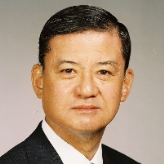Officials
Back to Officials


Offical

Name: Shinseki, Eric
Current Position: Former secretary
The highest ranking Asian-American in US military history, Eric K. Shinseki became a visible critic of the Bush administration’s force plan for the invasion of Iraq in 2003, correctly forewarning a problem that would haunt American military planners and policymakers in the years that followed. Barack Obama announced his nomination of Shinseki, a decorated Japanese-American war veteran, to be Secretary of Veteran Affairs on December 7, 2008—the 67th anniversary of the Japanese attack on Pearl Harbor.
Shinseki was born on the island of Kaua’i, Hawaii, to Japanese-American parents on November 28, 1942, during World War II. One of his uncles served in the Japanese-American 442nd Regimental Combat team, the most decorated Army unit during World War II. Shinseki grew up with his grandparents in the Japanese section of a plantation community and graduated from Kaua’i High School in 1960. He went on to attend the United States Military Academy at West Point, where he graduated in 1965 with a Bachelor of Science Degree. He also earned a Master of Arts Degree in English Literature from Duke University, and later attended the Armor Officer Advanced Course, the United States Army Command and General Staff College, and the National War College.
Commissioned as a second lieutenant, Shinseki served two combat tours with the 9th and 25th Infantry Divisions in Vietnam as an Artillery Forward Observer and as commander of Troop A, 3rd Squadron, 5th Cavalry. During his service in Vietnam, he was wounded three times. In April 1966 shrapnel from a mortar round hit him in the shoulder and chest. Five months later, a helicopter crash left him with a broken jaw and broken arm. In April 1970, during his second tour of duty in Vietmnam, Shinseki stepped on a land mine which blew off part of his right foot. The Army wanted him to retire at that point, but he refused. He was awarded two Purple Hearts and three Bronze Stars while serving in Vietnam.
Shinseki then served in Hawaii at Schofield Barracks in the headquarters of the US Army Hawaii and at Fort Shafter in the headquarters of the US Army Pacific. He later taught at the US Military Academy’s Department of English. During duty with the 3rd Armored Cavalry Regiment at Fort Bliss, Texas, he served as the regimental adjutant and as the executive officer of its 1st Squadron.
Shinseki went on to serve more than 10 years in Europe in a variety of assignments. These included the following, all with the 3rd Infantry Division (Mechanized): commander of the 3rd Squadron, 7th Cavalry (Schweinfurt); commander of the 2nd Brigade, (Kitzingen); Assistant Chief of Staff G3 (Operations, Plans and Training) (Wuerzburg); and Assistant Division Commander for Maneuver (Schweinfurt). He also served as the Assistant Chief of Staff, G3 (Operations, Plans and Training) with the VII Corps (Stuttgart), and as the Deputy Chief of Staff for Support, Allied Land Forces Southern Europe (Verona, Italy).
From March 1994 to July 1995, Shinseki commanded the 1st Cavalry Division at Fort Hood, Texas. In July 1996, he was promoted to lieutenant general and became the Deputy Chief of Staff for Operations and Plans for the Army. In June 1997, Shinseki was appointed to the rank of general before assuming duties as the Commanding General of the US Army in Europe, followed by his posts as commander of the Allied Land Forces in Central Europe, and commander of the NATO Stabilization Force in Bosnia-Herzegovina.
In November 1998, Shinseki assumed duties as the 28th Vice Chief of Staff for the US Army. He was then promoted to Army Chief of Staff on June 22, 1999. At one point, he sent copies of the book America's First Battles: 1776-1965, edited by Charles E. Heller and William A. Stoft, to members of Congress as a warning that too often, too many lives are lost in the first battles of wars because od lack of preparedness.
In March 2001, Shinseki angered many in the military with his plan to have all Army soldiers wear black berets, an honor previously reserved for elite forces. It was later revealed that the extra berets the Army needed were to be made in China and other foreign countries, a detail Shinseki said he did not know until after the contract was signed.
In order to discourage qualified personnel from leaving the Army, Shinseki promoted such soldier-friendly reforms as rotating non-combat troops only in summer to cause less disruption to families and to delay transfers for soldiers with a child who is a high school senior until after graduation.
On February 25, 2003, three weeks before the invasion of Iraq, Shinseki testified before the Senate Armed Services Committee that the US should send a much larger military force than was planned in order to defeat the Iraqi army and properly maintain order once the US had assumed control of the country. Secretary of Defense Donald Rumsfeld and Deputy Secretary of Defense Paul Wolfowitz ardently rejected Shinseki’s assessment. “The notion that it would take several hundred thousand American troops just seems outlandish,” said Wolfowitz. Unfortunately, Rumsfeld and Wolfowitz were wrong and Shinseki was right.
Three and a half months later, Shinseki retired from the Army. During his 38 years as a soldier, he became the highest-ranking Asian-American in US military history.
Since retirement, Shinseki has been appointed to the boards of two defense contractors: Honeywell and Ducommun Inc., and he also served on the board of directors of BancWest Corp.
Karmic justice: Gen. Eric Shinseki (by James Fallows, The Atlantic)
Retiring Army Chief of Staff Warns Against Arrogance (by Thom Shanker, New York Times)
Army Chief Raises Estimate of G.I.s Needed in Postwar Iraq (by Eric Schmitt, New York Times)
Army Chief Seeks Changes to Improve Lives (by Thom Shanker, New York Times)
Interview with Eric K. Shinseki (PBS Frontline)
- Latest News
- D.C. Public Schools will Teach all Second-Graders to Ride a Bike
- New Rule in Germany Limits Sales of Sex-Themed E-Books to 10pm to 6am
- What Happened to the 6-Year-Old Tibetan Boy the Chinese Government Kidnapped 20 Years Ago?
- U.S. Ambassador to Turkey Photoshops his Hair Color to Mock Turkish Mayor
- Mystery Artist Calls Attention to Unfixed Potholes by Drawing Penises around Them




